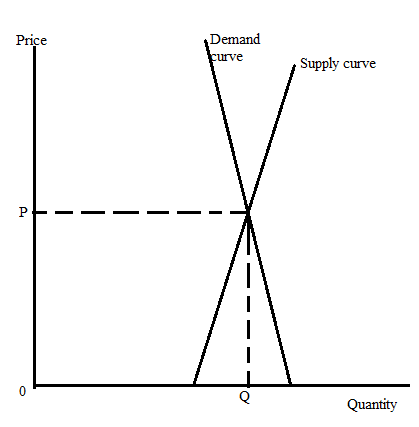
The
Explanation of Solution
If the market in kidneys were legal, then the demand and supply curves look like the ones shown in the diagram.
The demand and supply for the kidney are relatively inelastic because this is the organ that a person needs in emergency situations despite its high cost. The demand for human organs is inelastic in nature.
If the market of kidneys is legal, then the person who needs the kidney would get them despite fluctuating prices.
The demand and supply mechanism keeps the market for the kidney in equilibrium.

If the law that prohibits the sale of kidneys exists in a market, the demand for kidneys will still remain the same. But since the supply is restricted, now a person can only donate the organ instead of selling them.
Suppose in the presence of a law that prohibits the selling of organs, X quantity of kidney is donated by peoples.
Since selling is prohibited, the supply curve is a vertical line parallel to the y-axis because supply is limited and cannot increase according to the market demand.
This explanation is shown in the graph, where the x-axis represents the quantity of the kidney and the y-axis represents the price for the kidney.

The ban or prohibition on the sale of human organs promotes barter exchange, other illegal activities and the black market in organ transfers.
Want to see more full solutions like this?
Chapter 3 Solutions
ESSENTIALS OF ECONOMICS-CONNECT ACCESS
- Since humans have two kidneys, you could sell a kidney and still live a long, healthy life. Given that there is such a demand for organs, do you think we should allow individuals to sell their organs like kidneys? Who do you anticipate would be most likely to sell their organs and who are the most likely to buy organs? Do you foresee any unintended consequences of legalizing the sale of organs?arrow_forwardThe graph below shows the market for medical services in a country. Initially, there is no government health care system and the price per unit is 200 TL. Then the government decides to provide health care program in which the citizens pay only 40 TL for any medical acre they take. Government’s total health care expenditure is ………………. Citizens’ total health care expenditure after government health care program is ………. The amount of deadweight loss due to government health care program is …………………arrow_forwardHow to draw a graph to show the demand for face masks in the USA against the coronavirus? How to draw a price ceiling graph to show government intervention to stop the high prices on masks sales?arrow_forward
- Explain how each of these situations will affect the quantity demanded of health insurance: a) A reduction in the tax-exempt fraction of health insurance premiums. b) An increase in buyer income. c) An increase in per capita medical expenses.arrow_forwardAssume that the government decides to subsidize the price of healthcare. The subsidy will be given directly to individual consumers of medical-related goods and services. Who is likely to benefit more from this subsidy: Providers (doctors, nurses, hospital staff, etc....) or Patients? Explain your answer using a supply and demand diagram.arrow_forwardCompare the market for baby products and the market for childbirth (via either vaginal delivery or cesarean section procedure), then discuss the concept of ‘Agreement of Trade’ in both markets. Using illustrations, briefly explain how the following economic concepts find significance in understanding the market for health and health care: Scarcity, Choice and Opportunity Cost Efficiency and Equity Benefit-Cost Principlearrow_forward
- Can Hispanics be treated as a single market?arrow_forwardWhat would happen if, in order to provide lower cost healthcare, the government decided to set a price ceiling (Pmax) in the health insurance market?arrow_forwardThe graph below shows the market for medical services in a country. Initially, there is no government health care system and the price per unit is 200 TL. Then the government decides to provide health care program in which the citizens pay only 40 TL for any medical acre they take. Total health expenditures without any government health care program is …………… The amount of medical services per year when government provides health care is ………….. Total health expenditures with government health care program is ……………… Government’s total health care expenditure is ………………. Citizens’ total health care expenditure after government health care program is ………. The amount of deadweight loss due to government health care program is …………………arrow_forward
- Draw the demand curve in the market for medical care and upload your picture of your diagram, the horizontal axis should represent the number of medical procedures.) Show the quantity of procedures demanded if each procedure has a price of $100. On your diagram, show the quantity of procedures demanded if consumers pay only $20 per procedure. If the cost of each procedure to society is truly $100, and if individuals have health insurance as described above, will the number of procedures performed maximize total surplus? Explain. Consider how health insurance affects the quantity of healthcare services performed. Suppose that the typical medical procedure has a cost of $100, yet a person with health insurance pays only $20 out of pocket. Her insurance company pays the remaining $80. (The insurance company recoups the $80 through premiums, but the premium a person pays does not depend on how many procedures that person chooses to undertake.)arrow_forwardDraw a graph showing how demand for medical care changes under health insurance where the insurance policy pays a % of costs. What happens to demand elasticity? Amount purchased at any price? What does this say about the effect of health insurance on individual vs. social “perceptions” of health care cost and benefit?arrow_forwardHealth insurance coverage is expanded to cover all elective procedures, such as tummy tucks, nose jobs, and liposuction. The likely consequences of this event in the U.S. market for cosmetic surgery are? and why?arrow_forward
 Exploring EconomicsEconomicsISBN:9781544336329Author:Robert L. SextonPublisher:SAGE Publications, Inc
Exploring EconomicsEconomicsISBN:9781544336329Author:Robert L. SextonPublisher:SAGE Publications, Inc

 Economics (MindTap Course List)EconomicsISBN:9781337617383Author:Roger A. ArnoldPublisher:Cengage Learning
Economics (MindTap Course List)EconomicsISBN:9781337617383Author:Roger A. ArnoldPublisher:Cengage Learning





